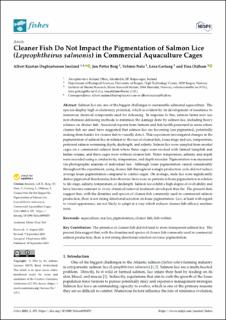| dc.description.abstract | Salmon lice are one of the biggest challenges to sustainable salmonid aquaculture. The species display high evolutionary potential, which is evident by its development of resistance to numerous chemical compounds used for delousing. In response to this, salmon farms now use non-chemical delousing methods to minimize the damage done by salmon lice, including heavy reliance on cleaner fish. Anecdotal reports from farmers and fish health personnel in areas where cleaner fish are used have suggested that salmon lice are becoming less pigmented, potentially making them harder for cleaner fish to visually detect. This experiment investigated changes in the pigmentation of salmon lice in relation to the use of cleaner fish, louse stage and sex, temperature, preferred salmon swimming depth, daylength, and salinity. Salmon lice were sampled from snorkel cages on a commercial salmon farm where three cages were stocked with farmed lumpfish and ballan wrasse, and three cages were without cleaner fish. Water temperature, salinity, and depth were recorded using a conductivity, temperature, and depth recorder. Pigmentation was measured via photographic analysis of individual lice. Although louse pigmentation varied considerably throughout the experiment, using cleaner fish throughout a single production cycle did not reduce average louse pigmentation compared to control cages. On average, male lice were significantly darker pigmented than females, but otherwise there were no patterns in louse pigmentation in relation to life stage, salinity, temperature, or daylength. Salmon lice exhibit a high degree of evolvability and have become resistant to every chemical removal treatment developed thus far. The present data suggest that, with the densities and species of cleaner fish commonly used in commercial salmon production, there is not strong directional selection on louse pigmentation. Lice, at least with regard to visual appearance, are not likely to adapt in a way which reduces cleaner fish efficacy anytime soon. | en_US |
